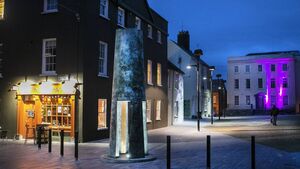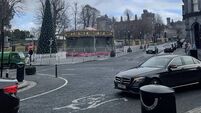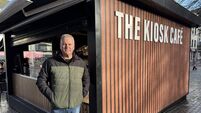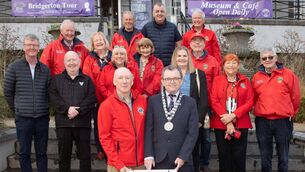Phoenix: Moving to the edge

Cathedral Square in Waterford city. Redevelopment of vacant sites in the city centre is in all our interests and a bigger centre city population helps with urban vitality and increased footfall. Photo: Joe Evans
Last week, a journey to the Six Cross Roads area was very instructive. It’s a voyage of discovery to an area, which once was very much removed from the city, to find it developing rapidly.
Housing developments are springing up everywhere in the Kilbarry and Lacken areas and places like the Black Rock on the Tramore Road, which once seemed very far out of town, will be surrounded by houses in the not too distant future.
The story is the same in Carrickphierish, Ballygunner and Ferrybank and in surrounding areas like Tramore, Dunmore, Passage and Kilmeaden.
A recent CSO report shows strong population growth locally, so housing development must continue apace if people are to find a place to live.
It is interesting to read that the national population has doubled to circa 5.6 million since 1960. It is also interesting to learn that the number of private cars on Irish roads has more than trebled to 2.4 million since 1995.
This latter statistic is obvious to anyone living or working in Waterford city. We have a generally well-developed road network in and around the city, but capacity issues are emerging in many places. Attempts to adjust traffic flows in places like the Williamstown Roundabout, or with a small one-way system on Passage Road elicit howls of disapproval or are taken as an attack on personal freedoms.
Who would want to be a road traffic engineer?
Had the Outer Ring Road, which was after all designed and planned by the City Council, not been developed in the first decade of this century, Waterford city would be utterly gridlocked, yet this successful project is rarely mentioned in the negative commentary on the council’s performance.
The volume of rush hour traffic on the Outer Ring Road is often incredible for a small city like Waterford. But road capacity can only deliver so much while we persist in our love affairs with suburban living and the private car.
Some green activists suggest that it is a zero-sum game, with more roads inevitably leading to more traffic and more cars, but with the schools back from their summer holidays, the ritual delivery of suburban children by car to their place of education starts again.
Two things offer partial solutions to our suburban, car-focused lifestyles: better public transport and redevelopment of decayed or underused central areas.
Public transport in Waterford city has seen positive developments in recent years. We have a seven-day, functioning bus network in the city with sensible links to Tramore, Dunmore, Slieverue and Carrick-on-Suir.
People are using the services. That much is obvious from simple observation.
The high-capacity link between the city and Tramore was vital this year in ferrying people to the seaside. The biggest problem with city bus services is the lack of dedicated bus routes, which means that buses compete with private cars for road space and often face delays. It’s easy to say that a competition between a vehicle capable of ferrying 50 people to its destination and one carrying four or fewer is nonsense and that public transport should have priority everywhere in the city.
Not many people would relish the thought of selling that idea to a very jaundiced public.
Cycle lanes have a very obvious role to play also but locally these tend to be a narrow and often dangerous (and bumpy) piece of curbside road carriageway.
Public transport links to the city and its hinterland will inevitably be further developed in the coming years. Cycle users will hope that cycle lanes, more like the fully segregated facilities in other European countries, will be developed.
Bringing more people to live in our city centre is a no brainer. All available sites have easy access to public utilities and services.
Redevelopment of vacant sites in the city centre is in all our interests and a bigger centre city population helps with urban vitality and increased footfall.
The spin-off to small retailers and restaurants can be significant.
Every Irish urban area, large and small, has problems with vacancy and dereliction. In some instances, property remains empty or unoccupied for decades.
Vacant sites used as surface car parks can linger for a lifetime.
Economists suggest that these symptoms are a sign of wealth rather than lack of money. If people needed the money they would sell on, but instead, under Irish law, people can sit on dereliction for a generation while awaiting speculative gains.
There are many buildings and sites in public ownership, which need attention - including the former Ardree Hotel overlooking the city.
The lovely 18th century terrace of shops on Parade Quay was acquired by the council. Plans to redevelop the area are posted on the empty shop windows.
A nice selection of small shops was closed there in the heart of the Viking Triangle to facilitate sensible redevelopment, but nothing has happened. Announcements were made of redevelopment in places like Hanover Street, The Glen, Summerland Square, without subsequent action. Quite obviously, delays in acquiring older properties or in ascertaining ownership consume a huge amount of council time and money, but progress is glacial.
Our council is very active at present in pursuing the owners of derelict and rundown property and has had some major success.
Unfortunately, problematic and highly visible areas, like New Street, Browne’s Lane, Newgate Street and Stephen Street, are still rundown or partially derelict. These undermine what is otherwise very good work.
That area is a huge hole in our urban landscape and needs priority redevelopment.
Vandalism in Wyse Park is probably symptomatic of a lack of people and residents in that area, as much as anything else.
The ongoing, long-term failure to attract private investment into the older city centre area may eventually only be solved by a new, national urban renewal tax scheme. Nonetheless, the council cannot be the developer of last resort in this city.
While it is sensible to seek inward funding for urban renewal in the city centre and elsewhere, local property owners must show the way with their own significant investment. The Glassworks 1 building on the Cork Road shows what must be done.






